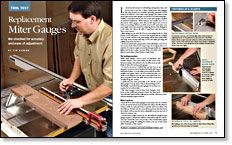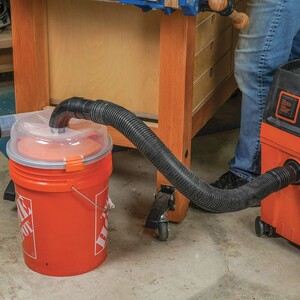Tool Test: Replacement Miter Gauges
We checked for accuracy and ease of adjustment
Synopsis: Tim Albers, a woodworker and machine refurbisher, put 10 replacement miter gauges to the test. He tried out the traditional protractor head, the Incra products with their rack-and-key adjustment, and the Osborne product with its triangular support system. Each miter gauge is described in detail, and Albers shares his views on which are best.
From Fine Woodworking #165
Look in just about any woodworking catalog these days, and you’re sure to see two or three replacement miter gauges. But why should you consider spending upwards of $150 when your tablesaw came with a miter gauge? The reason is that most replacement miter gauges are precision woodworking jigs—usually a vast improvement over the crude miter gauges supplied as standard equipment. While features and quality vary on replacement miter gauges, they all provide improved accuracy when crosscutting. All have positive stops at 90° and other common angles and some means for adjusting the fit of the sliding bar to the miter slot. Almost all offer a long fence, and most fences have a stop system.
Miter gauges won’t solve all of your crosscutting needs. For wide boards, you’ll still need a crosscut sled. Boards that are roughly 12 in. or wider will force the miter gauge off the front of the table, and long, heavy boards will drag on the saw table, pivoting and pulling away from the fence.
However, metal miter gauges have some advantages over wooden crosscut sleds: They won’t warp or go out of square, they cut a number of common angles accurately, they generally are lighter and easier to place on and off the saw table, and they accommodate a tilted blade or dado head.
While miter gauges can be used on bandsaws, disc sanders, shapers, and router tables, for this review I limited my testing to the tablesaw, the machine most people think of when discussing miter gauges.
To test for accuracy, I verified that my saw was set up properly. I took test cuts in lumber that had freshly ripped and jointed edges, so both edges were perfectly parallel, straight, and square. Then I cut off a section from the end of the stock, flipped over the piece, and placed the two pieces together on the saw table. An accurate cut showed no light along the cut line.
I performed the same procedure at 45° and 60° on all miter gauges (except those with no fixed settings at 60°). And finally, I used all of the miter gauges in my shop over a period of several months.
The miter gauges come in three basic designs: variations on the traditional protractor head, the Incra products with their rack-and-key adjustment, and the Osborne product with its triangular support system.
I used all 10 of these miter gauges in my shop, but two of them stood out and received more use than the others: the Woodhaven Deluxe (with its optional fence) and the JDS Accu-Miter.
For the full article, download the PDF below.
Fine Woodworking Recommended Products

Stanley Powerlock 16-ft. tape measure

Estwing Dead-Blow Mallet

Dustopper Pro






















Log in or create an account to post a comment.
Sign up Log in